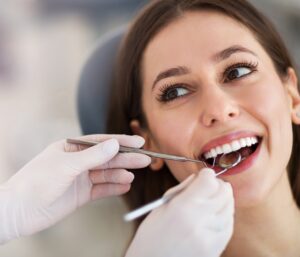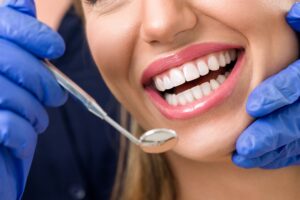Header logo
header top contact widget
Aesthetic Gum Treatment
Cut Dental Costs With Simple Steps
Posted on Dec 15, 2021 by William J. Claiborne, DDS MS
In order to avoid costly repairs on our vehicles, we rotate our tires, have the oil changed periodically, and make sure certain fluids are at sufficient levels. This is why our annual inspections are so important; risks can be pointed out to keep us safely on the road.
The same is true with our family’s health. We stay proactive by eating healthy, staying active and having regular check-ups along with periodic screenings.
It simply makes sense to be committed to preventing problems or catch any that do arise at early stages. Research has shown that your oral health deserves the same commitment you give to maintaining a healthy body.
Studies have found a correlation between the bacteria of periodontal (gum) disease and serious problems elsewhere in the body. These include heart disease, stroke, diabetes, arthritis, preterm babies, impotency and more.
Another reason to maintain a healthy smile is to save money. By devoting about 5 minutes per day to your oral hygiene routine, coupled with having dental exams and cleanings every six months, you can prevent many problems from occurring in the first place. The reward is a savings in time and expense that may be needed for repairs – repairs that may have been prevented from occurring in the first place.
Your twice-a-year dental check-ups are opportunities to remove tartar. Tartar is a cement-hard mass of oral bacteria that forms when plaque (the sticky film that coats teeth and gums) is not removed thoroughly attaches to teeth and can no longer be brushed or flossed away.
Both plaque and the hardened mass of tartar are the result of accumulated bacteria. Oral bacteria continually reproduce in the mouth, which provides a warm, dark and moist environment. As they thrive and reproduce, they attack gum tissues.
As they amass to levels beyond what the immune system, oral bacteria can lead to gingivitis (an early stage of gum disease). Unresolved, gingivitis can develop into periodontal disease, an infection. Eventually, periodontitis develops, which is an advanced level of gum disease. At this level, teeth often loosen and must be removed.
While gingivitis causes tender gums to bleed when brushing, periodontal disease symptoms are more severe, including persistent bad breath, sore gums that bleed easily, gums that darken in color, receded gums, and pus pockets that form between teeth.
As devastating as adult tooth loss can be, the potent bacteria of gum disease can enter the bloodstream through tears in disease gum tissues. Research has shown the infectious bacteria of gum disease can activate or worsen the development of certain pathogens.
Obviously, oral bacteria is highly potent. However, it’s easy to control with twice daily brushing and daily flossing combined with regular dental checkups. For added protection, limit sugary snacks and either swish after eating or chew sugarless gum when brushing is inconvenient. Not only will you help to reduce your risk for cavities and gum problems, you’ll be able to enjoy fresher breath and smiling confidence.
It is also important to respond early to signs and symptoms of gum disease. As mentioned above, things like frequent bad breath or seeing blood in the sink when brushing are warning signs that something is wrong.
A periodontist is a dentist who has specialized skills in the diagnosis and treatment of all levels of periodontal disease. He or she can also recontour the shape of gums and place dental implants for optimal results.
If you have not seen a dentist on a regular basis, you may be experiencing symptoms that indicate gum disease. As you would respond to a warning sign with your overall health, so should you with your oral health.
Begin with a thorough examination to determine what your needs are and the best way to achieve and maintain good oral health. You’ll be supporting your overall health in addition to having a confident smile.
If dental fear has prevented you from having regular dental care, ask about sedation options. We offer both oral sedation and IV sedation (twilight sleep). Both are safely administered and you are closely monitoring throughout treatment.
You may wish to begin with a consultation. To schedule, call 828-274-9440.
Even OTC Pain Relievers Have Risks.
Posted on Dec 09, 2021 by William J. Claiborne, DDS MS
When we see new patients in our Asheville periodontal dental office, it’s common to hear comments about how the appointment was the most thorough they have ever experienced. We pride ourselves on our dental hygienists’ skills for dental cleanings, exams of gum tissues, and in advising patients of ways to maintain good oral health at home.
As a periodontal specialist, I perform a thorough examination of the teeth and oral tissues, both visually and through digital imaging (x-rays). In some cases, we use Cone Beam 3D imaging. Our goal is to have an in-depth view of each patient’s oral anatomy and intricate areas that can reveal problems, both potential and existing.
Our hygienists also work to consider the patient’s whole health so we can tailor their treatment to unique needs. They typically begin by noting any medications the patient takes, both over-the-counter or prescription. Herbal supplements taken regularly are also noted. Why?
The number of American adults who regularly use medications for pain relief has significantly expanded. For most mild to moderate pain, preferences for non-prescription pain relievers (analgesics) now lean towards non-steroidal anti-inflammatory drugs (NSAIDs) or acetaminophen.
There are a wide variety available over-the-counter (OTC), which means they are readily available without a prescription. Because these can be purchased right off the shelf, many people assume these medications are safe.
What consumers often miss, however, is the fact that many of these can have side effects. They can also interact with other medicines, dietary supplements, and alcohol consumption. Because pain medications contain the same ingredients found in a number of prescription drugs, adults may actually be taking a risky dose when combining medications.
According to a report from NBC News, Americans are taking too much of over-the-counter pain relief meds. In a study conducted by a Boston University School of Health researcher, nearly one in five users of popular headache remedies like Advil or Aleve admitted exceeding the recommended daily maximum dose during a one-week period.
Due to the side effects and without medical oversight, this can lead to higher risk for serious health problems, including gastrointestinal bleeding and heart attacks.
Before taking these meds, it’s important to get to know the types of pain medications (also known as analgesics) and how they work.
NSAIDs are an acronym for non-steroidal anti-inflammatory drugs. In this category are pain relievers that include aspirin, ibuprofen (Advil, Motrin), and naproxen sodium (Aleve, Naprosyn), and ketoprofen (Orudis).
Non-steroidal anti-inflammatory drugs reduce pain and inflammation by inhibiting production of prostaglandins, which are the hormone-like substances that cause them. Unfortunately, NSAIDs also block other prostaglandins that protect the stomach lining, regulate blood flow to the kidneys, and support blood clotting.
This is bad news for people who are regular users of NSAIDs or those who take high doses since they increase the potential for stomach inflammation, peptic ulcers, and intestinal bleeding. This is especially true for older adults. Taking NSAIDs in high doses or for an extended time can increase this risk even more.
An alternative is acetaminophen (Tylenol, Anacin-3, etc.), which relieves pain by affecting the areas of the brain that receive pain signals. Acetaminophen is best when the need is to reduce pain and fever, but is essentially ineffective in calming inflammation. The up side, however, is it will not cause the bleeding or clotting problems that have been associated with NSAIDs.
Yet, just as NSAIDs have a down side, so does acetaminophen. This analgesic is metabolized by enzymes in the liver. Taking too much can lead to liver damage in susceptible people, such as those who drink alcohol regularly. This is why it is important to read the labels of any medication so you don’t exceed the maximum daily dose of acetaminophen.
For most, taking non-prescription pain relievers – as directed on the label – is generally safe. The potential for trouble arises when you combine the following:
• Some NSAID and acetaminophen products, as well as cold, sinus, and allergy remedies, contain a blend of pain relievers. Kidney damage can result from extended use of painkillers that combine analgesics from different sources.
• A wide number of prescribed painkillers contain acetaminophen, such as Darvocet and Vicodin. Some prescriptions contain NSAIDS, including Celebrex and Percodan. Before you combine prescription medications with over-the-counter painkillers, be sure to check with your prescribing doctor first.
• NSAIDs can interact with other drugs, especially ACE inhibitors, anticoagulants, beta blockers, lithium, and methotrexate. Aspirin interacts with anticonvulsants, corticosteroids, insulin, and sulfa antibiotics. If you take any of these prescription medicines, check before using NSAIDs or aspirin.
• People are often surprised to learn that some herbal supplements, including garlic, ginger, feverfew, ginkgo, and ginseng, can thin blood. You should avoid taking these supplements while taking NSAIDs. When having procedures that may involve bleeding gums, these supplements, or combining them with NSAIDs, can complicate your procedure and the healing process.
One of the reasons we request updates on the medications you take at each visit is to provide you with optimal care. We want your oral health to support your overall health, and vice versa. Be a careful consumer of the medications you take, whether OTC or prescribed.
If you have questions, call 828-274-9440. You may want to begin with a free consultation to get to know us, or schedule complete periodontal examination, especially if you have signs or symptoms of periodontal (gum) disease. These include:
• Sore, tender gums that bleed easily while brushing teeth
• Frequent bad breath
• Gums that recede from the base of teeth, exposing darker, more sensitive sections of the tooth’s root
• Gums that are swollen
• Gum tissues that darken to more of a red color versus a healthy pink
If these signs exist, it is important to seek a periodontal evaluation as soon as possible. Gum disease will only worsen without treatment and is the nation’s leading cause of adult tooth loss.
At Biltmore Periodontics in Asheville, we are always happy to see new patients. A referral is not always needed.
Contour of Gum Tissues Is Important To A Smile’s Appearance
Posted on Oct 28, 2021 by William J. Claiborne, DDS MS
When people think of their smile, they tend to think primarily of their teeth. Certainly, having white, straight teeth are a major part of a smile’s appearance. In today’s cosmetic dentistry, porcelain veneers and crowns give an exceptionally natural appearance with excellent longevity and durability. However, the gum line that borders teeth can greatly affect a smile’s appearance, perhaps more than you’ve considered.
People with unflattering smile traits tend to “hold back” when smiling. They may smile with lips only or hold a hand in front of their mouths. Some men even admit to growing a mustache that extends down over the top lip to hide the teeth visible in a smile.
In addition to placing dental implants and treating all stages of gum disease, a Periodontist specializes in the treatment of the soft tissues of the mouth. As an expert in oral tissues, my advanced training enables me to contour gum tissues to provide a natural appearance and healthy seals around the base of teeth.
For several reasons, gum tissues can pull away from the base of teeth. This can occur from gum tissues becoming drier with age or over-zealous tooth brushing. Gums can also loosen their grip around teeth when teeth tilt out of their proper positions.
When the tight seal around the base of teeth is compromised, the tooth becomes more vulnerable to oral bacteria. Darker, sensitive tooth root segments may be exposed. This not only causes sensitivity, these areas become susceptible to bacterial penetration. As an entry point for oral bacteria, the tooth roots and bones that support teeth are more vulnerable to damage as well.
In cases when a tooth breaks near the gum line, a procedure known as crown lengthening may be able to expose enough of the tooth structure so a crown can be placed. This means the natural tooth can be saved rather than require removal. Once a natural tooth is removed, it brings with it a long list of decisions and associated costs.
Although protecting and saving teeth is the priority, gum contouring procedures, such as crown lengthening are also performed to enhance the appearance of a smile. Gum re-contouring is typically referred to as a “gingivectomy”. It is performed to remove the excess gum tissue that arches over the teeth most visible in a smile.
For example, for people who have a “gummy smile,” too much gum tissue is visible above upper teeth in a full smile. A periodontist can use his or her specialized skills to reshape the tissues to provide a more balanced smile line.
In this, crowns are typically placed in addition to having the gum height adjusted. The result? A smile is greatly improved when the gum line is contoured to blend attractively with gum tissue bordering neighboring teeth.
To begin, we numb the gum tissues and carefully trim the excess. As a Periodontist, I take specific measures to ensure a natural looking arch remains over the teeth while preserving the natural points that ‘dip’ between each tooth.
A gingivectomy performed with a dental laser provides our Asheville periodontal office patients with a number of advantages: (1) enhanced comfort; (2) precision lines; (3) minimal or no bleeding; and, (4) faster healing time.
It’s normal to experience some tenderness or swelling after the procedure. However, most patients do fine by applying an ice pack off and on for the first day. In most cases, over-the-counter pain medications are sufficient, however, we make prescription strength options available to ensure comfort during the healing process. Many patients tell us they needed no medication at all.
Healing time depends on each individual and can vary from a few days to a few weeks. The dental laser we use helps to reduce the amount of time needed for healing. For patients who smoke, healing times are longer due to smoking’s drying effect on gum tissues.
Most gingivectomies are followed by porcelain veneers or crowns to give a beautiful, even smile line.
For those who have avoided gum recontouring due to dental fear, we offer several sedation options, including oral and IV sedation. Oral sedation is a pill that helps patients relax. It also has an amnesiac effect, leaving most with little or no memory of treatment afterward.
IV sedation (also known as ‘twilight sleep’) places the patient in a deeper sleep state and erases memory of the procedure. It is administered by a doctor of anesthesiology for optimal comfort and safety. In our Asheville office, anesthesia is overseen by a medical doctor (MD) who is a board certified Anesthesiologist.
With both sedation options, patients are closely monitored with advanced safety equipment throughout treatment. We help patients understand that their fears and concerns are not unusual. Our doctors and staff respect each patient and provide gentle, compassionate care – at every appointment.
Treatment fees depend on the extent of the condition and whether crowns or veneers will be applied following treatment. In either case, beautiful results can occur, helping the individual who once ‘held back’ on smiling confidently.
A healthy smile is a benefit to our overall health. An attractive, confident smile is also an asset when it comes to self-image, helping us to feel good from the inside out! Call 828-274-9440 for a consultation to discuss a gingivectomy and what may be recommended for your specific needs.
What’s Keeping You From The Dentist’s Office?
Posted on Oct 19, 2021 by William J. Claiborne, DDS MS
As an Periodontist in Asheville NC, I’ve treated many patients who, to no surprise, developed periodontal (gum) disease because of NOT going to a dentist on a regular basis.
According to the Centers for Disease Control & Prevention (CDC), nearly 65 percent of adults aged 18 and over had at least one dental visit in the past year (based on 2019).
https://www.cdc.gov/nchs/fastats/dental.htm
Unfortunately, that leaves 35 percent of adults who did not. 
The reason it is recommended to see a dentist for exams and cleanings TWICE A YEAR is because tartar, which is hardened plaque, can cause cavities and gum disease. One plaque hardens into tartar, it can no longer be brushed or flossed away. It must be removed by a dentist or hygienist using special tools.
Tartar is actually a mass of oral bacteria, which has attached itself to the base of (or in-between) teeth. Tartar (also referred to as calculus), is a colony of bacteria that thrive on oral tissues. Bacteria are living organisms and reproduce rapidly. And, the more there are, the more rapidly they amass.
So, what are the common excuses for avoiding regular dental care? See if you’ve been guilty of one or more:
COST – Some individuals feel dental cleanings and exams are expensive. Actually, there is a great deal of time and training that goes into your individualized care. In addition to the measures of sterilization and instruments, hygienists and dentists are highly-trained, educated, and must stay board certified. As for the investment, these visits are what help you avoid the need for a filling, gum disease, potential damage to teeth due to bite misalignment, and even catch oral cancer at early stages. If dental insurance is not possible, ask if payment plans are available. Many dental offices offer these, most of which are interest-free with no down payment required.
DENTAL FEAR – If fear or anxiety keeps you away from a dental chair, you are not alone. It is estimated that over 70 percent of American adults have some level of this. Sometimes the fear exists because of a traumatic experience in the past or feeling helpless in the chair. Some people react to certain smells and sounds. A few have no idea what prompted their fear, but know it is beyond their control. For these, we advise seeking dental care in a modernized office. Today’s advanced technology has greatly enhanced the level of comfort during care as well as reduced treatment time. Too, offices such as our Asheville periodontal dental office offer oral sedation as well as IV sedation (twilight sleep). These are administered by highly-skilled professionals who oversee the patient using advanced safety monitoring equipment. Ask for a consultation and tour before choosing the office that is reassuring to your unique needs.
DREAD OF BEING LECTURED – If it’s been years since you’ve seen a dentist, you may be expecting a lecture from the dentist or hygienist (or both!). My staff and I believe that is a sure way to deter someone from cultivating a positive attitude towards their dental relationship. We all want to feel respected and having a caregiver talk “down” to you is unfair, especially because no one knows the story behind your delay or avoidance. If you feel that’s going to be a problem, say so. Be upfront with “a lecture is not going to help me.” If you feel it’s a recurring problem, ask to have your records transferred to an office where you are treated more appropriately.
FEAR OF EMBARRASSMENT – Some adults feel awkward having their denture or partial removed at the dentist’s office. Some people fear they’ll gag during care, which can trigger coughing and even throwing up. Some feel their mouths are so “bombed out” that it’s embarrassing to have a dentist see how much damage has occurred. To reassure you, there is nothing we haven’t seen or experienced. Dentists have quite a lot thrown at us during dental school. As a specialist in periodontics, my additional training covered even more in-depth and complex damage or disease. DO NOT worry about your caregivers. They WANT you to rely on them to help you. Almost any dentist or specialist will tell you that our greatest joy comes from taking a patient from a “hopeless” mouth to a patient who has a healthy, confident smile!
TIME IN TREATMENT – Today’s advanced technology has greatly condensed the time needed to accurately diagnose and treatment plan almost any dental problem. Many treatments can be completed in just one or two visits. For those who have more extensive needs, dentists can sometimes combine several appointments into one long one. This is made much easier for the patient with the addition of oral sedation. Oral sedation creates a totally relaxed state so the patient can “doze” in and out of treatment. It has a quick recovery and sedated patients are carefully monitored for safety and comfort throughout treatment.
Regardless of WHY you’ve avoided the dentist, your smile is worth it! Having an appealing smile you feel joyful in sharing adds to your mood, enhances appearance and makes a positive impression to others.
If you’ve avoided dental care for years (or even decades), you may have signs or symptoms of periodontal disease. These include tender gums that may bleed when brushing, gums that recede from the base of some teeth, gums that turn red in color, and frequent bad breath. Gums are the foundation for teeth, so without healthy gums, your teeth will not be healthy, either.
Too, gum disease will only worsen without treatment. If you are a reader of my articles, you may have read the findings of research that correlates the bacteria of gum disease with serious health conditions. These include stroke, heart disease, preterm babies, some cancers, arthritis, diabetes, and erectile dysfunction.
Let us help you feel the positive aspects of achieving a healthy smile. Begin with a consultation by calling 828-274-9440.
Recent Posts
Categories
Archives
- September 2024
- August 2024
- July 2024
- June 2024
- May 2024
- April 2024
- March 2024
- February 2024
- January 2024
- December 2023
- November 2023
- October 2023
- September 2023
- August 2023
- July 2023
- June 2023
- May 2023
- April 2023
- March 2023
- February 2023
- January 2023
- December 2022
- November 2022
- October 2022
- September 2022
- August 2022
- July 2022
- June 2022
- May 2022
- April 2022
- March 2022
- February 2022
- January 2022
- December 2021
- November 2021
- October 2021
- September 2021
- August 2021
- July 2021
- June 2021
- May 2021
- April 2021
- March 2021
- February 2021
- January 2021
- December 2020
- November 2020
- October 2020
- September 2020
- August 2020
- July 2020
- June 2020
- May 2020
- April 2020
- March 2020
- February 2020
- January 2020
- December 2019
- November 2019
- October 2019
- September 2019
- August 2019
- July 2019
- June 2019
- May 2019
- April 2019
- March 2019
- February 2019
- January 2019
- December 2018
- November 2018
- October 2018
- September 2018
- August 2018
- July 2018
- June 2018
- May 2018
- April 2018
- March 2018
- February 2018
- January 2018
- December 2017
- November 2017
- October 2017
- September 2017
- August 2017
- July 2017
- June 2017
- May 2017
- April 2017
- March 2017
- February 2017
- January 2017
- December 2016
- November 2016
- October 2016
- September 2016
- August 2016
- July 2016
- June 2016
- May 2016
- April 2016
- March 2016
- February 2016
- January 2016
- December 2015
- November 2015
- October 2015
- September 2015
- August 2015
- July 2015
- June 2015
- May 2015
- April 2015
- March 2015
- February 2015
- January 2015
- December 2014
- November 2014
- October 2014
- September 2014
- August 2014
- July 2014
- June 2014
- May 2014
- April 2014
- March 2014
- February 2014
- January 2014
- December 2013
- November 2013
- October 2013
- September 2013
- August 2013
- July 2013
- June 2013
- May 2013
- April 2013
- March 2013
- February 2013
- January 2013
- December 2012
- November 2012
- October 2012
- September 2012
- August 2012
- July 2012
- June 2012


